The final vestige of the grandest try ever to link the Hawaiian islands by ferry has come to an end on Kauai. The state recently issued a bid request to remove the Hawaii Superferry ramp at Nawiliwili Harbor on Kauai. It’s anticipated to cost up to a quarter million dollars to remove the ramp and chain fence link components.
The Hawaii Superferry tried hard but, in the end, was not successful in combining passenger, frieght, and vehicle ferry service. It’s a concept that was discussed, planned, and tried for decades as a way to improve critical interisland travel for passengers and cargo.
While the Hawaii Superferry was a bust, there is something new on the horizon that may open another opportunity and offer a smoother ride. It too, however, isn’t without controversy. Hopefully, the history of the Superferry may lead to a better experience.
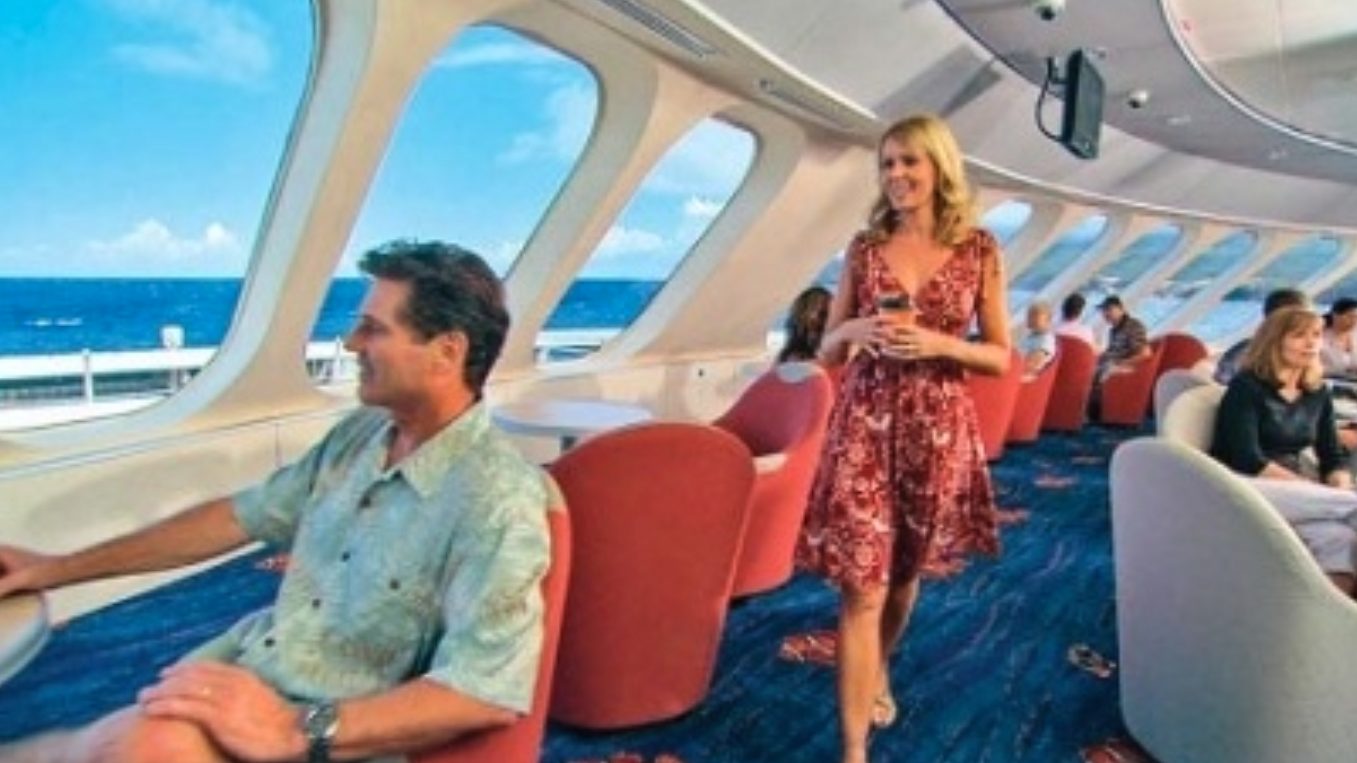

The start and end of the Hawaii Superferry.
The first time we learned about the Hawaii Superferry was in the late 1990s. The company was formed in 2003 and acquired and modified two high-speed catamarans. One launched in 2007 and ended service in 2009. The catamarans were then sold at auction to the US Navy.
While in service, there were problems and controversies. In addition to that, the ride was not always smooth. As one rider said, “Loved it when the water was nice and flat. It was a nightmare when seas were rough. I knew it would be rough so I was usually drugged up for those segments. But it was borderline comical watching attendants following passengers with barf bags as the ship rocked back and forth for 2-3 hours.”
It was argued, among other things, that the Superferry threatened humpback whales and posed other environmental threats, including vehicles bringing with them invasive species and potentially worse. While the ferry planned to service Kauai, it abruptly changed plans after the 2007 maiden voyage made news nationally as surfers and others protested into Nawiliwili Harbor, and effectively blocked the vessel from landing for hours.
The Hawaii Legislature passed a law that permitted the Superferry to run as an environmental impact statement was being readied. However, legal battles ensued, demanding it be done prior to operations and not concurrent with them. The Hawaii Supreme Court ruled that allowing Superferry to operate without a second complete environmental study was unconstitutional.
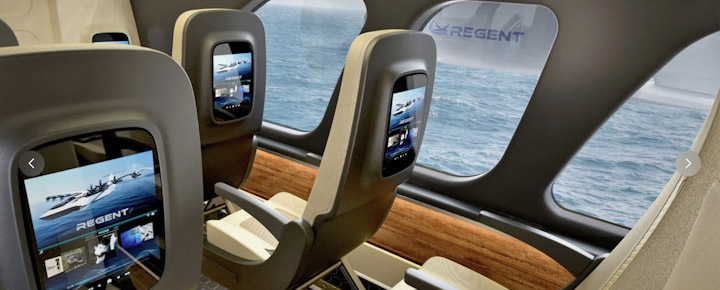

Exciting developments are on the horizon for ferry-like Hawaii transportation.
In a groundbreaking move last year, Hawaiian Airlines announced its investment in the Regent Monarch, a cutting-edge, all-electric Seaglider with a 100-person capacity. This move sparks intriguing questions and opens up a new chapter of possibilities for ferry-like interisland transportation in Hawaii. It remains to be seen if Alaska Airlines will continue with the project if they can complete the acquisition of Hawaiian Airlines next year.
Earlier this year, Regent unveiled a full-scale mock-up of its revolutionary Seaglider. The company also announced the addition of “Aerospace Titans Dennis Muilenburg and David Neeleman to (its) Board of Advisors.” That while Miami-based Surf Air revealed plans for Seaglider service and the US Marines and Regent will demonstrate Seaglider technology in the Littorals.
The Regent Monarch, is set to commence commercial deliveries in 2028. It represents a mesmerizing hybrid ferry/aircraft designed for the latest Hawaii harbor-to-harbor service. It aims to address the void left by the failed Hawaii Superferry and could revolutionize travel within the islands.
Once airborne, the seaglider utilizes a phenomenon known as the “ground effect,” rising just above the water’s surface for efficient lift. The manufacturer emphasizes its ability to maneuver within harbors like a boat and transition to plane-like operation in open waters.
Hawaiian Airlines is not the sole player in this ambitious, modern sea ferry venture.
Southern Airways Express, Mokulele Airlines’ parent company, made a substantial $250 million purchase of 15 of Regent’s 12-passenger Viceroy seagliders and 5 of the 100-seat Monarchs. This strategic move positions Seagliders as potential replacements for traditional interisland flights.
The overarching goal is to provide Hawaii with interisland transportation that is more cost-effective, environmentally friendly, and less noisy than existing options. Regent envisions seagliders as a game-changer for regional transportation, addressing Hawaii’s unique interisland needs. These all-electric vehicles boast speeds of 200 mph with the operating cost of a boat, aligning with the goal of convenient, comfortable, and environmentally sustainable travel.
While this presents an exciting prospect for travel in Hawaii, questions abound.
Are these considered TSA-secured flights or boat travel? How will they impact Hawaii’s wildlife, including humpback whales? That and navigating rough water are perhaps the two most widely discussed concerns. Despite these queries, the potential benefits include similar travel times to current air travel experiences while avoiding airports, and the prospect of a unique ocean travel experience.
Notably, this isn’t the first attempt at interisland ferry service in Hawaii. Far before the Superferry, SeaFlite operated for nearly three years with and technical and financial challenges leading to its early demise. Now, as Hawaii dreams of a reliable ferry system, the Regent Seaglider initiative raises hope for a successful and transformative transportation alternative.
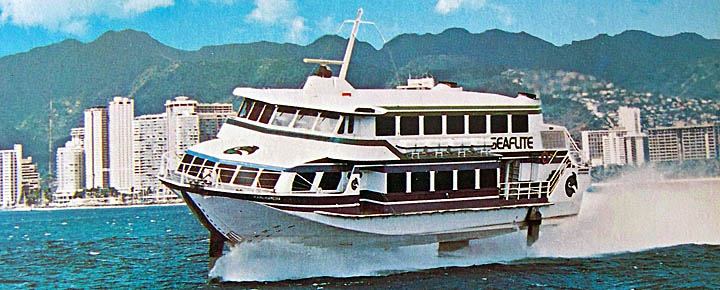

Even before Superferry, there was SeaFlite.
Operating for nearly three years, the SeaFlite service utilized three vessels before ceasing operations primarily due to financial challenges. Subsequently, the boats found a new purpose in Hong Kong. During its existence, the service offered up to 12 daily runs but eventually folded, with a substantial $20 fare for each one-way trip.
The Boeing Jetfoil 929-100 hydrofoils were acquired by Honolulu-based SeaFlite in 1975 for service between the Hawaiian Islands. They operated until the company folded in 1979.
Seasickness has always presented problems on Hawaii ferries.
At the time of SeaFlite, these were supposed to be smooth riding since they skimmed just above the waves. That turned out to not be the case, however. There was also a fire on one of the boats, as well as a collision with a Coast Guard boat. The Boeing 929 turned out to not be reliable and cancellations were frequent. There were concerns about Hawaiian humpback whale collisions back then as well, although we are not aware of any that actually happened. Superferry suffered from seasickness issues as well. That problems is supposed to be eliminated from the Regent vehicle however, since it primarily operates above the water.
Please share your thoughts on Hawaii ferry service, future and past.
Get Breaking Hawaii Travel News
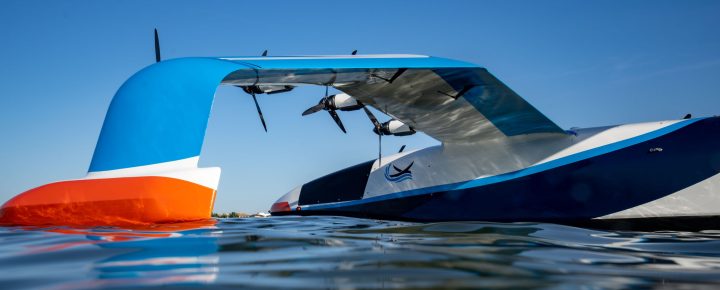

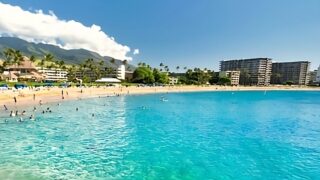

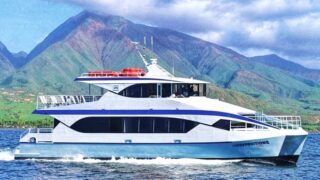
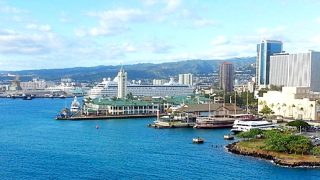
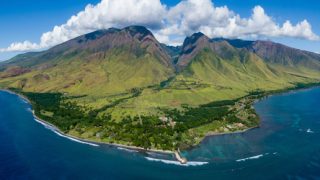
I rode on one of these in the late ’70’s when Boeing tested them in Seattle. When we pulled away from the dock, the vessel bobbed in the water like a cork until it turned around and got going fast enought to get up it’s skis. I was shocked how quickly it was possible to get sea sick.
The problem was that the hydroflil cost as much as a 737 and was a massive gas hog. All of the energy nessary to keep it up on the skis came from the fuel. It’s possible the wing of the Seaglider will provide enough lift that the fuel use problems will be better.
The hydrofoil never made any business sense. It was developed after the recession in the mid-’70’s basically to give the engineers some to do and in hope to land a navy contract
We should have a ferry like Alaska’s Marine Railway System that is owned by the state. The ferries are capable of moving large construction vehicles, regular cars and people to the different towns/ports. These ferries are regular ships that can handle different ocean conditions. You can ride one from Bellingham WA and go to Juneau and Anchorage. I had an enjoyable trip.
John’s comment contains a revisionist history of the HSF debacle. The HSF investors badgered the HDOT for an environmental studies exemption before the service started. There was slew of mid level HDOT staff that believed they should do EIS beforehand, but were overruled by the Lingle administration.The ferry opponents filed a lawsuit in the Maui Circuit Court in 2005 asserting a EIS needs to be conducted due to the harbor improvements at Kahului. Judge Cardoza ruled in favor the state. Judge Cardoza’s ruling was appealed to the HawSCT, who reversed the lower court’s decision in 2007.The state legislature passes legislation overruling the Maui court decision allowing the HSF to operate. The HawSCT invalidated the legislation in 2009.
Revisionist HIstory is sometimes in the eye of the beholder. The Hawaii Super-Ferry was a great idea, and local businesses loved it. For the first time in Hawaii local businesses could easily, quickly, & cheaply ship their goods interisland, along with their vehicles. That was much to the dismay of the airlines, car rental companies, & the one (1) interisland shipping company that still holds a monopoly on that business. The cost of shipping everything interisland by air is prohibitively expensive. The Hawaii Legislature legalized the HSF. If there had been a thousand E.I. statements and studies, it would never have been enough. The Hawaii Supreme Court decision was flawed and political.
John, please re-read my previous comment. The HSF badgered the HDOT to exempt the HSF from doing a EIS before the service
started in 2004. There were mid level HDOT staff that concurred a EIS should’ve been conducted first, but the Lingle administration
ignored the warnings. The Supreme Court rulings were based on the rule of law. There was nothing political about either 2007 or 2009 court opinions. HDOT tried to circumvent HRS 343 (HEPA)
and failed miserably. We, as taxpayers, were left with lingering consequences.
Interesting discussion on the various modes of inter island travel. The Seaglider will never carry the cargo and automobiles that the Superferry did.
Regarding Seaglider and TSA, there would be no connection to transpacific travel if terminals are at the ports.
Additionally, the only reason interisland air travel is subject to TSA is that you arrive inside security and can continue on to international destinations. If HNL had terminals specifically for interisland travel only it would make it much easier and less restrictive to fly and take things with you.
It is my understanding that TSA screen all commercial flights as commercial aviation is covered by federal not state law.
Mokulele is interisland only and there is no TSA involved. You do not arrive inside security or at an airport such as Kapalua which has connecting flights.
The Hawaii Superferry was actually a hit with most who rode it. Sure saved the cost of an inter-island car rental. Those in Hawaii the week after 9-11 sure wished they could travel inter-island, but all planes were grounded. No mail delivery & no paychecks. The Hawaii Superferry was actually a great way to whale-watch, traveling slower in whale season (6 months/year). I lived on Maui then, and the “non-profit” whale-watching tour boats hated the competition. They spent big bucks hiring attorneys to fight it. The Hawaii Supreme Court’s decision was political, and would have been overruled, if left to a vote of the people. A minority of protesters on Kauai do not a majority make.
When living on Maui in the 70’s we took a ferry (superfoil) I think, it was great.
Hi Sandi.
That’s cool. You might be the first one to report traveling on that. Thank you for 200 comments to date.
Aloha.
Aloha.
Hawai`i needs an interisland ferry. Planes are inefficient and too polluting. We need options.
Will this require going through the TSA and all the other hassles associated with airline travel? Or will it be a truly ferry-like experience?
Interisland acceptable, affordable, travel is and has been so needed. Hawaii needs to get itself together and do whatever it takes to have its residents travel between islands affordably and easily.
Hawaii :: you are decades behind yourself. Get with it and provide for your homeland residents.
How far above the water will the seagliders fly?
Will they be able to deal with large waves?
Mahalo for a really succinct and accurate analysis of the Superferry. The residual ignorance from some of the letters about the so-called positive aspects of that ill-conceived, illegal, and useless enterprise is astounding and reflects a mentality that suggests that some will accept any negative qualities if only they can have what they want. Meanwhile, how about waiting for all of the facts before spouting opinions and considerations with almost no information about the Seaglider? It might be great and it might be another nightmare (Yes, the Superferry) but the devil will be in the details, as they say.
Guess you’ve never been to Seattle & ridden any ferry-boat, along with your car, down below, to any of the dozens of destinations from Seattle. Sure works well. It’s not rocket-science. As far as choppier seas, there are tons of daily ferry-boats across the English Channel, between France & England, etc. This is not the 1800’s.
What happens when a whale breeches in front of the plane?
They fly very low!
I absolutely love the idea of an all electric Seaglider, but my main concern would be during whale season, especially since it mentioned 200 mph. Still better than regular speed boats, especially since Seaglideres would be able to go up in the air and wouldn’t use gasoline.
sometimes nothing new is the best solution.
Anything that moves on the water is subject to wind and waves. Unless you are traveling on a submarine, you are going occasionally encounter even moderate seas that are going to involve ‘bobbing around’ and people are going to get seasick or even injured. Sea conditions change without notice, so schedules are hard to maintain. Also, the cost of operations of a ‘ferry or shuttle’ by water will invariably be higher than presented by the project promoter. Next, who actually is going to patronize this service? Will there be enough patronage to keep the system going at even a modest profit. And then, those current interisland airlines, who are competing with the system, who may cut airfares to put the ferry out of business.
Like the SuperFerry these gliders are not problem-free. 1) They may not touch the waves, but will encounter 30-50 mile per hour winds in island channels. 2) They need a whole new set of terminals and large adjacent parking areas near each of the harbors. Is land even available? 3) If the planes substitute for present inter-island flights, where will the present airport authority (with fewer landing fees) get the funds to maintain/operate the existing airports? 4) Construction of port terminals and parking will necessitate a major EIS because it will be operating on State land.
I took a ride on the trial runs. I loved it! I didn’t experience sea sickness although I get seasick.
It didn’t go because of the encroachment on the unions and surfers. We were so looking forward to taking a camping trip on the other islands with the whole family. A shame that a minority stopped a good thing from the majority for reasons.
One issue I see is that there will still be a lack of competition. What’s needed is another carrier that is not Southwest, Mokulele, or Hawaiian.
So where are our elitist climate change intelligensia? Don’t they see any benefit from a reduced carbon impact by fewer inter-island air flights?
As for water roughness, are we to believe Hawaiian ferry crossings worse than ferries long used on the North Sea, the English Channel, the Baltic, other routes known for rough crossings?
Robert B.
The super ferrys would have been great. But the Airlines and Young Brothers didn’t want competition. To bad because Young Brothers has a Monopoly that cost all of us. Let other ships carry cargo between Islands.
Competition is good just look at Hawaiian airlines who had s Monopoly for years. Now with Southwest prices are reasonable.
Any medical flights should be at a major discount because we need to travel to Oahu for care.
Ekranoplan rises like a phoenix. I guess the Malahinis from the North Shore will have to buy some hang gliders to kill this off…..
All electric, , how long would it take to re-charge?